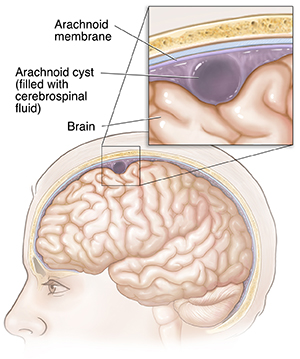Arachnoid Cyst (Leptomeningeal Cyst)
An arachnoid cyst is a fluid-filled sac of the brain or spinal cord. It forms between the brain or spinal cord and the arachnoid membrane. This membrane is a thin layer of tissue around the brain. It’s one of the protective coverings around the brain. An arachnoid cyst contains cerebrospinal fluid (CSF). This is a normal fluid that’s found around the brain and spinal cord. These cysts appear most often in children, but they may also form in adults.

What causes an arachnoid cyst?
The cyst may form during the first few weeks when a baby is growing in the womb. This is called a primary arachnoid cyst. In some cases, the cyst may appear later in life. It can be caused by a head injury, meningitis, tumors, or brain surgery. This type is called a secondary arachnoid cyst. These are less common than primary arachnoid cysts.
Symptoms of an arachnoid cyst
The symptoms vary depending on where the cyst is and its size. In many cases, a small cyst may not cause any symptoms. Some cysts cause no symptoms until they grow large.
Symptoms may not be the same for each person and can include:
-
Headache
-
Nausea and vomiting
-
Vertigo or dizziness
-
Problems hearing or seeing
-
Trouble with balance and walking
-
Seizures
-
Behavioral changes
-
Changes to the skull bones
An arachnoid cyst on the spinal cord can compress the cord or nerve roots and cause:
Diagnosing an arachnoid cyst
A healthcare provider may discover a cyst when it shows up on an imaging scan done for another reason. Or a person may have symptoms from the cyst.
To make a diagnosis, a provider may refer you to a neurologist. This is a doctor who specializes in diagnosing and treating diseases of the central nervous system (brain and spinal cord). Or you may be referred to a neurosurgeon. This is a surgeon who does brain or spinal cord surgery.
The process to diagnose a cyst starts with a medical history and a physical exam. Your provider will ask about your symptoms and past medical conditions. They may also ask about your family’s medical history. The physical exam may include a neurologic exam. Imaging tests may be done to look at the brain. Contrast dye may be used to help show more detail in the images. The tests may include:
-
Computed tomography (CT) scan. This is a test that uses a series of X-rays and a computer to create images of the inside of the body. Scans may be done of your brain and spinal cord.
-
MRI. This test uses large magnets and a computer to create images of the body. MRI scans of your brain and spinal cord may be done to get more information about the cyst and nearby tissues.
Scans may be repeated over time to see if the cyst is growing.
Treatment for an arachnoid cyst
Treatment depends mostly on the location and size of the cyst and if it's causing symptoms. If the cyst isn’t causing symptoms and isn’t growing, your provider may choose to watch it closely with repeated brain scans. If you need treatment, your provider may puncture the cyst sac and drain the fluid. The fluid drains into the CSF. If a brain cyst is causing problems, your provider may advise removing it with surgery.
Possible complications of an arachnoid cyst
An untreated arachnoid cyst may cause permanent neurological damage as it expands or if it causes bleed. Discuss treatment choices with your provider.
Call 911
Call 911 if you have:
-
Severe sudden headache
-
Seizures
When to call your healthcare provider
Call your provider right away if you have any of these:
-
Nausea and vomiting
-
Vertigo or dizziness
-
Problems seeing or hearing
-
Trouble with balance and walking
-
Back and leg pain
-
Numbness and tingling in arms or legs